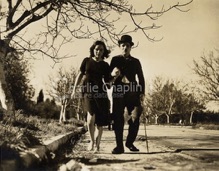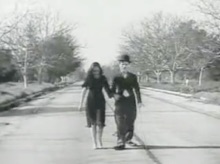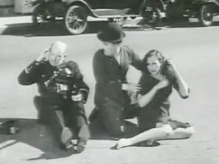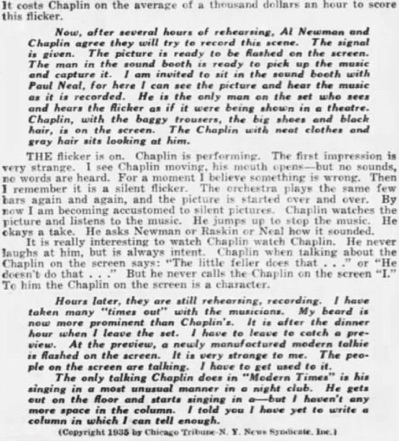Modern Times 1935 1936 1937 next previous
Modern Times Clippings 205/382
Sidney Skolsky, Daily News, New York, November 26, 1935.
Modern Times Scenes
& Modern Times Scene, Charlie Chaplin Picture Data Base
„It is really interesting to watch Chaplin watch Chaplin“
Editorial content. „Hollywood
By SIDNEY SKOLSKY.
Chaplin‘s ,Modern Times‘
Hollywood, Nov. 25.
CHARLIE CHAPLIN is now scoring his flicker, Modern
Times. This means that the picture is finally completed
and edited. Modern Times is the most important scoring task
in Hollywood, for the Chaplin flicker is silent, and it is
through the musical arrangements and sound effects that it will
talk. Chaplin has written an original musical score and
suggested the known music being used.
Chaplin sits in a camp chair on a large recording set at the
United Artists‘ studio, supervising the scoring. His hair
is gray. He has a stubble gray beard. He wears black patent
leather shoes with white suede tops, and his right arm
is carried in a sling. A blue silk muffler serves as the sling.
Chaplin broke his right thumb in the door of his auto.
Al Newman stands on a small platform, waving a baton
at sixty-five musicians. David Raskin, who made the
music arrangements for Chaplin, is also present to supervise.
There is a screen hanging in mid-air in back of the
orchestra. The part of Modern Times being scored will
be shown on this screen. Chaplin is chewing gum
in time with the orchestra. Only a few of Chaplin‘s personal
friends among the magazine writers and several
visitors from the Soviet cinema have seen sections of the
picture. No newspaper man has seen a flash of it.
I walk on the set, stand and watch. Soon Chaplin sees
me. He grins a broad ,Hello‘ and then says it.
I approach him. ,I‘d like to watch you work. May I?‘ Chaplin
always has been congenial to me. ,Stay around,‘
he answers, ,but don‘t tell too much.‘ I promise. And
I believe I‘ll keep that promise, for I have yet
to write a column in which I believe I have told enough.
THE orchestra starts rehearsing the music for the
factory sequence in which Chaplin revolts against being a slave
of the machinery. He throws the place into confusion and
does a wild dance. The music is as difficult as the scene. Every
note must be timed exactly with the film, and the music
is not loud and brazen as expected of factory sounds.The
orchestra rehearses these few bars again . . . again . . . again.
An hour later, they‘re still doing those few bars. The
orchestra stops playing. The men leave their chairs. There‘s
time out for five minutes, like a football team. It is
strenuous work. The musicians work only three, four hours
at the most, at a stretch. Then they have an hour for
relaxation. Yesterday, they worked from nine in the morning
until 4 o‘clock the next morning, and about half a reel
was completely scored. It costs Chaplin on the average of
a thousand dollars an hour to score this flicker.
Now, after several hours of rehearsing, Al Newman and
Chaplin agree they will try to record the scene. The
signal is given. The picture is ready to be flashed on the screen,
and capture it. I am invited to sit in the sound booth with
Paul Neal, for here I can see the picture and hear the music
as it is recorded. he is the only man on the set who
sees and hears the flicker as if it were being shown in a theatre.
Chaplin, with the baggy trousers, the big shoes and black
hair, is on the screen. The Chaplin with neat clothes and gray
hair sits looking at him.
THE flicker is on. Chaplin is performing. The first impression
is very strange. I see Chaplin moving, his mouth opens –
but no sounds, no words are heard. For a moment I believe
something is wrong. Then I remember it is a silent flicker.
The orchestra plays the same few bars again and again, and the
picture is started over and over. By now I am becoming
accustomed to silent pictures. Chaplin watches the picture
and listens to the music. he jumps up to stop the music.
He okays a take. He asks Newman or Raskin or Neal how it
sounded.
It is really interesting to watch Chaplin watch Chaplin.
He never laughs at him, but is always intent. Chaplin
when talking about the Chaplin on the screen says: ,The little
feller does that . . .‘ or ,He doesn‘t do that . . .‘ But he
never calls the Chaplin on the screen ,I.‘ To him the Chaplin
on the screen is a character.
Hours later, they are still rehearsing, recording. I have
taken many ,times out‘ with the musicians. My beard
is now more prominent than Chaplin‘s. It is after the dinner hour
when I leave the set. I have to leave to catch a preview.
At the preview, a newly manufactured modern talkie is flashed
on the screen. It is very strange to me. The people on the
screen are talking. I have to get used to it.
The only talking Chaplin does in Modern Times is his
singing in a most unusual manner in a night club.
He gets out on the floor and starts singing in a – but I haven‘t
any more space in the column. I told you I have yet
to write a column in which I can tell enough.
(Copyright 1935 by Chicago Tribune-N. Y. News
Syndicate, Inc.)“
Modern Times world premiere will be in New York
Feb. 5, 1936 at the Rivoli Theatre.
Rivoli Theatre, Broadway at 49th Street, New York.
Redaktioneller Inhalt
Modern Times 1935 1936 1937 next previous




